Gem lovers, adventurers, history buffs take note! A labyrinth of marbleized tunnels gilded by a multi-color glow of fluorescent minerals below the earth awaits at Sterling Hill Mining Museum.
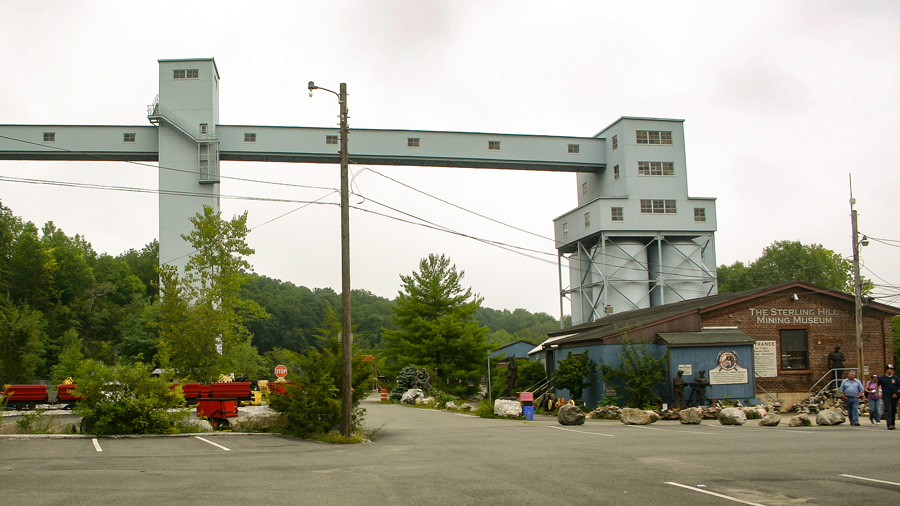
For years I heard of the gems once found in the mines of the Skylands Region: rubies, sapphires, garnet. The mines were an image of the past, ancestral, remote, almost exotic, and filled with gorgeous crystals of pink rhodonite, the rainbow colors of willemite, blood-red garnet and other precious beauties. They were a destination to see and maybe find, if I were lucky, a treasure all my own. Then a few weeks ago, I heeded the call of the mines. I was not disappointed.
As I turned onto Route 517 in Sussex County, I spotted the old brick buildings and remains of a mining mill tucked against the hillside overlooking the country town of Ogdensburg. Small cottages, once lived in by miners and their families, cluster near the old general store. Larger houses, just across the street from the mine, were occupied by the bosses so they didn't have to walk so far.
In the northwest town of Ogdensburg, Sterling Hill Mine is home to a world famous collection of minerals and fluorescent rocks. This geological gem contains over 340 mineral species, the largest combination anywhere, and over 70 of them fluoresce, the most in any spot on earth. The district is known as "The Fluorescent Capital of the World." Additionally, 35 of the minerals are rare, and are found nowhere else in the world. Sterling Hill Mine, and its sister mine in Franklin, have the richest deposit of zinc ore in the world, where it is mined as oxides and silicates without a sulfur component like in other mines. These phenomena have earned Sterling Hill Mine two titles of distinction: National Historic Site and a Mines, Metal and Men Site.
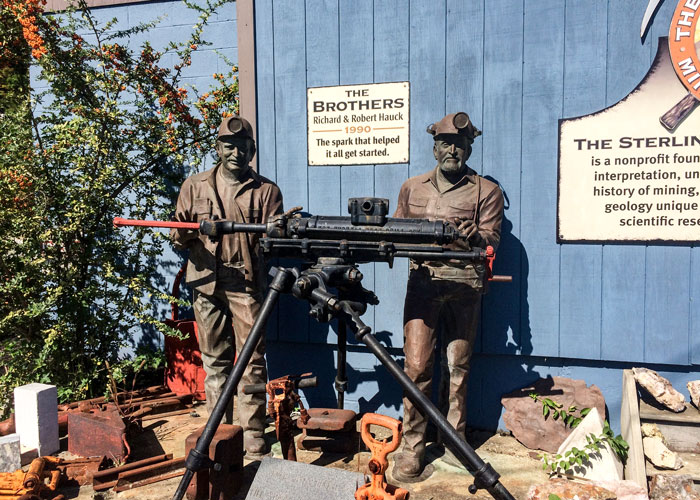
Ogdensburg was once a company town owned by the New Jersey Zinc Company. The mine closed in 1986, and in 1987 Dick Hauck and his brother Bob bought it at a tax sale. Two years later they turned it over to a non-profit, educational foundation, The Sterling Hill Mining Museum, dedicated to the preservation of the mine and its historical significance. Last year, over 33,000 people came to see the splendor of the mine's natural fluorescence, and the awesomeness of the tunnels made by man.
Sterling Hill Mine is a place where miners once blasted walls with black powder looking for zinc-filled ore, and others drilled ten-foot core samples trying to find the richest source. It's a place where workers wore self-rescuers. A place where muckers, drillers, and timbermen dug and blasted their own tunnels, and men carried dynamite on their backs - they "humped powder".
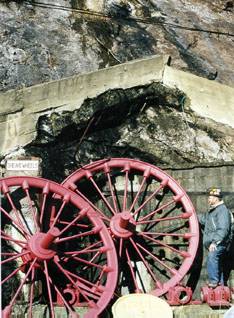
Today, you enter the mine through a ten-foot wide, horizontal tunnel called the "adit". Side tunnels shooting off the adit were added by the Foundation for ease in touring, but usually an adit went directly to a vertical tunnel, or "shaft" where men and materials were transported. The floors, walls and ceilings are Franklin marble, marbleized limestone, metamorphosed since its deposition in Pre-Cambrian times over 1.1 billion years ago.
As you walk further into the adit the huge wooden "air doors", once closed to keep the bad air out as part of the mine's air circulation system, are now swung wide. There are steel "square sets", sets of three steel beams used now instead of timber, fitted tight against the walls and ceiling to provide support after the tunnel was blasted and the ore cleared out. It's easy to imagine the miners stopping in the lamp room to pick up their lamps and "self-rescuers", small canisters that converted carbon monoxide to carbon dioxide, that lasted fifteen minutes.
Directly ahead is a monstrous, slanted gap in the marble. It's the main shaft that rises 150 feet, and drops nearly 2,000 feet down into the earth. The 53° angled shaft parallels the tilt of the orebody, a deposit that contains a large amount of zinc, that follows the dip of the mountain. You stand under the "footwall", or the underside, of the orebody that extends the length of the hillside the adit's dug into. The shaft has five compartments, four with roller-coaster-like tracks, and one for cables, pipes, and ladders. Two sets of tracks bring skips filled with ore up out of the mine and two sets carry cages that hold 40 men and materials. The shaft connects 18 levels that are approximately 100 vertical feet apart.
Walk past the end of the adit on a steel bridge over the "orepass", an angled pit that once ended at a rock crusher, but is now filled with water. Every level of the mine is connected to it. The original mine ends here as you walk through more adits and "stopes", rooms within the orebody itself where the ore was extracted. These were dug more recently by the Sterling Hill Mine Foundation.
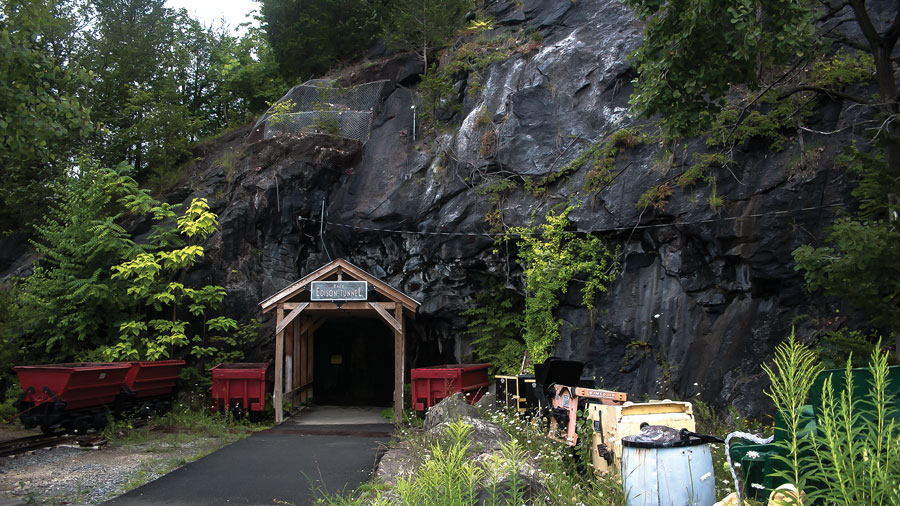
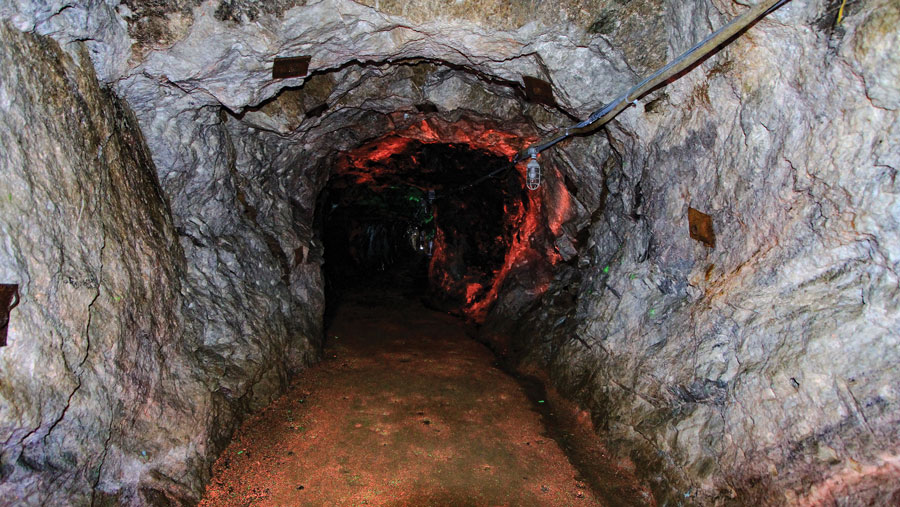
"Drifts" are tunnels that give access to the orebody. One marble wall shows a "drift round", a series of holes drilled into a tunnel wall that are ready to be filled with explosives for blasting. Some of the men lit fuses on sticks of dynamite with the lights on the front of their hats. You had three minutes to find safety. From the blast, the rock exploded and filled the stope with broken ore of all sizes.
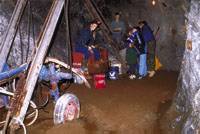
In the stope, in the black willemite zone, the "slusher" machine scrapes the fallen ore into a 4-foot diameter shaft sunk into the floor. The driver sits behind a screen, like a medieval windshield, made of steel bars and heavy chain to protect his face from getting thrashed by machinery cables that might break and whip back. Sometimes "muckers" worked, shoveling broken ore into cars. The shaft dumps ore into a car on the level below, then the car dumps the ore into the orepass. A "grizzly", or huge mesh-like screen in the orepass, catches the larger rocks that might clog the crushers. A man stood by, whose job was to beat these rocks with a sledge-hammer until they fit through the grizzly. The rock flows to a giant crusher machine, over a thousand feet below ground. The crushed ore drops to lower levels into skips that are hoisted to the surface, then on to the mill. In the mine, gravity moves most everything between levels. The emptied stope gets back-filled with waste-rock and a cement cap to prevent cave-ins. There are "raises" at each end of the stope skinny shafts that connect levels and allow air circulation.
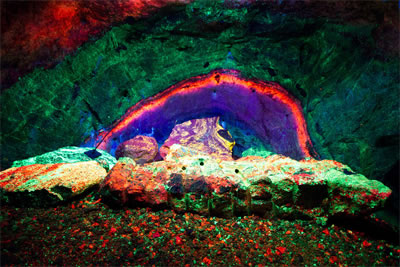
A fault cracks through the walls of the Rainbow Tunnel. Its surfaces gleam with flowstone. In other spots, the fault is highly polished forming a "slick and slide" from just the right amount of pressure over time. The Rainbow Room's walls and ceiling fluoresce with what the Sterling Hill Mine is famous for - the red of calcite in the marbleized limestone and the bright green of willemite, used to track the orebody.
The way to the Thomas S. Warren Museum of Fluorescence is through one of the original entrances to the mine that was buried for 100 years. The Haucks saw concrete foundations sticking above the earth and began digging. "It was sort of like digging out King Tut's tomb, it got bigger and bigger, " describes Bob Hauck, treasurer and facilitator of the Foundation. The early, extensive underground mine complex of Sterling Hill was started from 1830 to 1850, then in 1915 the company built an eight-story mill above ground for processing the zinc ore and housing the locker room where the miners showered and changed. It was torn down in the 1960s. The below-ground level is all that remains of the mill, and it's now the Geo Tech Center, with the Museum of Fluorescence as part of it. And all that glitters is not gold it's fluorite, willemite, and calcite too.
"The Thomas S. Warren Museum of Fluorescence is the greatest fluorescent center on earth," explains Ron Mishkin, a tour guide and one of the last remaining miners. Rocks were brought in from all over the world and some are from the mine. Fluorescent rocks were not important to the NJ Zinc Company, so they were not mined for their fluorescence. "It's the mecca of fluorescence," adds Hauck.
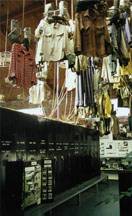
When mysteries remain in nature, people reflect. Theories abound why the Sterling Hill and Franklin Mines have the only zinc veins with oxides and silicates and no sulfur just franklinite, willemite, and zincite. "In order to get three minerals together and mine 33 million tons of them that haven't been mined anywhere else, it's a phenomenon," says Mishkin. "Something had to happen to cause the sulfur to go away to leave silicates and oxygen." One theory is that an undersea "smoker" spewed hot water up and deposited minerals heavy in iron, manganese and zinc onto the ocean floor in layers. During a billion years, mountain building, glaciation, fracturing and erosion affected the form of the mineral deposits into metamorphic rock. Glaciers melted and caused oxidation and water poured through the soft limestone to the ore deposit, causing a chemical reaction that changed the minerals. Over ten years worth of zinc ore is left in the mine, but the cost of removal exceeds its value. Most of the ore left is in the upper levels. The miners worked from bottom up.
There is much to see and do at the Sterling Hill Mine. Visit the museum, once the miners' locker room, with artifacts from mining days, baskets and clothes hung high to dry, boulders, gems, fossils, machinery, and an antique safe that weighs 5 tons that houses native gold from everywhere. Mine your own treasures of fluorescent minerals, crystals, and other rare specimens in the "dump". Dig through the section with rocks from all over the globe. They were brought up from the mine before it flooded when the mine closed.
Yes, the mine and museum were everything I had envisioned. You can experience the sense of men from not so long ago, whose job was to mine metals from the earth, while exposing the mineralogical richness and beauty and geological mysteries of the Skylands. Their mystique survives.
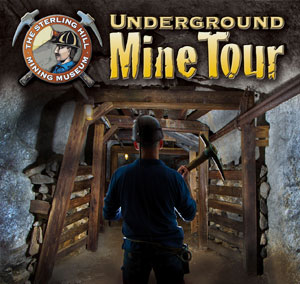
Sterling Hill Mining Museum is open for public tours. Visit the website for current tour schedule and special events.
30 Plant Street, Ogdensburg, NJ 973-209-7212.
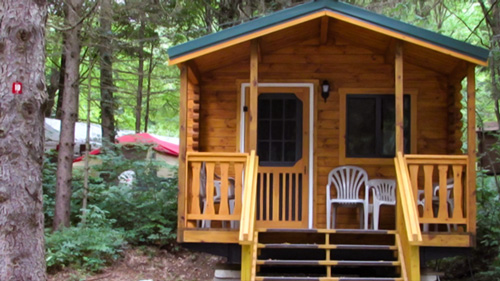
Located in Sussex County near the Kittatinny Mountains the camping resort offers park model, cabin and luxury tent rentals as well as trailer or tent campsites with water, electric and cable TV hookups on 200 scenic acres.
Peters Valley shares the experience of the American Craft Movement through interactive workshop learning through a series of workshops. A shop and gallery showcases the contemporary craft of residents and other talented artists at the Crafts Center...ceramics, glass, jewelry, wood and more in a beautiful natural setting. Open year round. Closed Thursday.
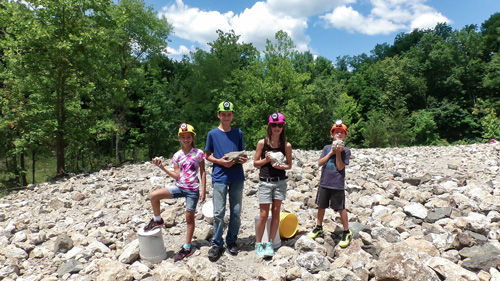
“The Fluorescent Mineral Capitol of the World" Fluorescent, local & worldwide minerals, fossils, artifacts, two-level mine replica.
Follow the tiny but mighty Wallkill River on its 88.3-mile journey north through eastern Sussex County into New York State.